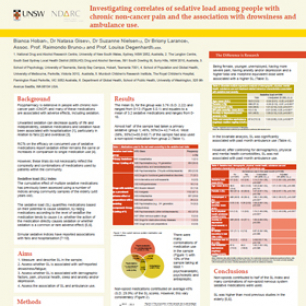This poster was presented by Bianca Hoban at the 2015 NDARC Annual Research Symposium.
Abstract
Aims: Polypharmacy is extensive in people with chronic non-cancer pain (CNCP) and many of these medications are associated with adverse effects, including sedation. The aims of this study were to: i) describe sedative load (SL) in a cohort of people with CNCP prescribed opioids, ii) assess whether SL is associated with self-reported drowsiness/fatigue iii) assess correlates of SL and; iv) assess the association of SL and ambulance use.
Methods: A total of 1,166 CNCP patients prescribed opioids were recruited from community pharmacies across Australia and completed a diary of their medication use in the past week. SL was calculated using a previously published index. Associations with SL were examined using multivariate regression, controlling for demographic characteristics, physical and mental health, substance use and total oral morphine equivalent dose.
Results: The mean SL for the group was 3.76 (S.D. 2.22) and ranged from 0-13. The most common sedative medications (in addition to opioids) were antidepressants (55%), benzodiazepines (28%) and antipsychotics (7%). SL was associated with self-reported drowsiness/fatigue. Being female, younger, unemployed, having more severe pain, anxiety/depression and a higher total oral morphine equivalent dose were associated with a higher SL. After controlling for demographic characteristics and physical and mental health comorbidities, SL was not associated with past month ambulance use.
Conclusion: People who use multiple sedative medications represent a group with complicated demographic and health profiles. They are more likely to be younger unemployed, have more severe pain and more mental health comorbidity. The SL index is just one approach to assessing adverse outcomes related to polypharmacy. While polypharmacy or multimodal medication use may be an appropriate approach to treatment, further research is required to assess if this approach is associated with adverse outcomes


